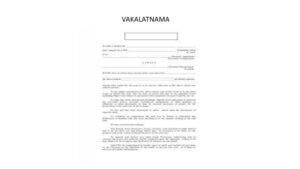Table of Contents
INTRODUCTION
A Vakalatnama is a legal document that authorizes an advocate or a lawyer to represent a client in court. It is a written agreement between the client and the advocate, granting the advocate the authority to act and make decisions on behalf of the client in legal proceedings.
Vakalatnama” is often referred to as “Vakalat” “Vakalath” or “Wakalat” in India. It is a legal document that authorizes a lawyer to represent a client in a court of law. The term “Vakalatnama” is derived from the Persian language, where “vakil” means “lawyer” and “nama” means “document” or “paper.”
MEANING OF VAKALATNAMA
The meaning of Vakalatnama is defined in the Advocates Welfare Fund Act, 2001 under section 2(u) It includes a memorandum of appearance or any other document by which an advocate is empowered to appear or plead before any court, tribunal, or other authority. The holder of the vakalatnama is called a pleader, an advocate, counsel, vakil, or an attorney who is authorized to accept the vakalatnama on behalf of his client or party of the litigation.

MEANING OF ADVOCATE
The meaning of advocate is defined in the Advocates” Welfare Fund Act, 2001 under section 2(a) “Advocate” means an advocate whose name has been entered in the State roll prepared and maintained by a State Bar Council under section 17 of the Advocates Act, 1961 (25 of 1961) and who is a member of a State Bar Association or State Advocates’ Association; the same meaning of advocate is mention in the advocates’ Act, 1961 Under Section 2 (1) (a) Advocate” means an advocate entered in any roll under the provisions of this Act.
Who can authorize a Vakalatnama?
The following can authorize:
- An aggrieved person can authorize a Vakalatnama
- Anybody holding the Power Of Attorney for the aggrieved person
- Anybody representing the aggrieved person in business or trade in that jurisdiction.
- A Vakalatnama can also be authorized by a joint party in a case in order to appoint either a set of advocates or the same advocate
Contents
A good Vakalat nama should contain the following:
- The date the Vakalat nama would be executed
- The name of the case/cases in which the advocate is being appointed
- The name of the court/courts in which the advocate is being appointed
- The name of the person authorizing the Advocate/advocates
- If the Vakalat nama is not executed by the issuer in person, then a written document should support the appointment of the advocate
- The advocate’s address so appointed
- The power is given to the lawyer
- Signatures of the parties
- Advocate’s signature accepting the Vakalatnama
Validity
A Vakalat nama is valid until:
- The death of the client; or
- The death of the lawyer; or
- The client withdraws it; or
- A court gives approval for the lawyer to withdraw it
- The conclusion of the court case
What are the terms under a Vakalatnama?
- Regardless of a lawyer’s decision, a client shall not hold him/her responsible
- All the legal costs involved in the case shall be borne by the client
- The lawyer has a right to keep the documents until all the agreed fees are paid
- At any stage of the legal tussle, the client is at liberty to disengage the lawyer
- The lawyer has the right to take any decision he/she deems fit during the hearing of the case
- A Vakalatnama is attached to the last page of a suit/plaint and it is stored alongside the court records
- A Vakalatnama does not require a fee. However, currently, the rules of the Delhi High Court require that applicants should pay INR. 10 on what is termed the “Advocate Welfare Stamp” which should be attached to the Vakalatnama.
- The court fee payment should be attached. The value of the court fees is usually a percentage of the claim’s value of the suit. Also, the amount is clearly mentioned in the Court Fees Stamp Act.
MUST READ
FILE A CASE AGAINST A PERSON WHO HAS NOT RETURNED YOUR MONEY
LEGAL RIGHTS AND DUTIES UNDER JURISPRUDENCE
